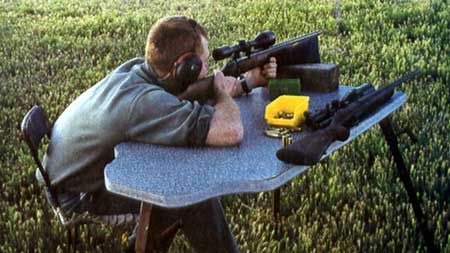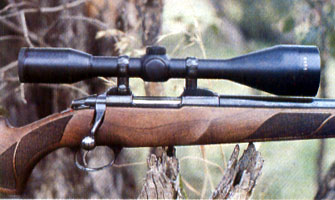
 |
The Lynx 8x56 is ideal for long
range varmint shooting as the fine reticle covers less of the target. |
 |
The Lynx 8x56 features excellent
optics and minimal parallax at all distances. |
Like all the other Lynx scopes I’ve previously tested, the P8x56mm exhibited excellent optics combined with minimal parallax at all distances and is capable of good results when the shooter does his part. This scope would be of great interest to professional kangaroo and varmint shooters as, it is definitely a serious competitor to the ever popular 8x56 Kahles.
To test the scope, we mounted it on a Sako 75 in .223 Rem, which from past experience, will let the scope put it’s best foot forward. Although the absolute twilight performance was a little behind the Kahles and Pecar, when using this scope under the spotlight for professional shooting, I didn’t once find it lacking for target shooting, with the Lynx slightly ahead of the Kahles because the reticle was finer and covered less of the target, and therefore had the potential to shoot better groups. The Editor and I also tried the big Lynx on long range rabbit shooting and it performed brilliantly, allowing shots out to 250 metres to be taken with ease.
 |
Checking
the repetability of scope click adjustments. |
As this scope is a relative newcomer to the market, some comparisons are of order. I was able to get hold of four other 8x scopes, ranging in age from an early 1960’s model (the Bushnell), to present day ones. I compared field of view at 100 meters, which wasn’t as easy as I thought; and clarity at dusk, when it is too dark to see much with the naked eye.
It is interesting to note that the field of view was the same as the old 8x42 Bushnell, with smaller lenses at the front and rear. This is one of the trade-offs for getting a permanently centred reticle (that is, an image moving scope). Both the Kahles and Pecar were reticle moving as well, which means the scope mounts have to be spot on or you’ll end up with the reticle out of it’s optimal centre of your field of view.
The Lynx is like all modern scopes, that is, they are image moving, which means the reticle stays perfectly centred regardless of the amount of adjustment required to make them shoot straight on your rifle. This doesn’t however, mean that you don’t need to bore sight these modern scopes and get the windage adjustments in your scope mount very close to spot on before you fire a shot.
Bore sighting is a reliable way of getting the scope pretty close to the target without firing a shot. Bore sighting is described in the Lynx instruction manual.
Generally, the 8x56mm Lynx performed as well as any scope I have shot with. The weight of the big Lynx came in at 500 grams, 100 grams lighter than the 8x Kahles. For general field shooting, the 8x is mostly too much magnification, but for a varmint rifle, or one that sees a lot of night work, it would be a good choice at a modest price.
| Scope | Field of View | Percieved Twilight Performance |
| Lynx 8x56 | 4.5m | Pretty good, but unable to see reticle on grassy bank |
| Kahles 8x56 | 5.05m | Excellent, just able to pick up reticle |
| Pecar 8x43 | 4.8m | Just behing Kahles |
| Bushnell 8x42 | 4.5m | On par with Lynx |
| Leupold 8x36 | 4.3m | Worst of all 8x scopes, to be expected because of lens size. |
| Tasco WC 3x9 | 4.1m | Okay in good light, poor at twilight. |